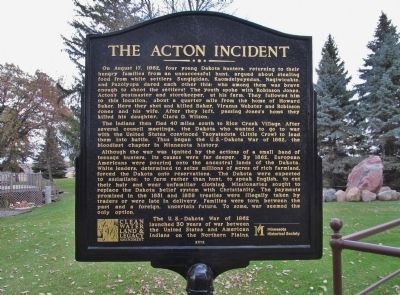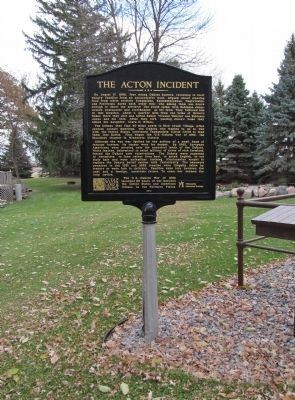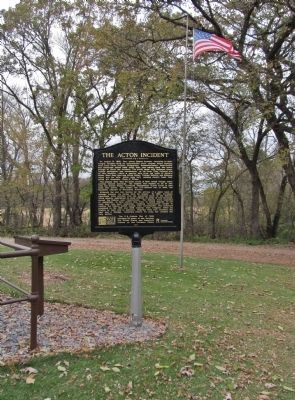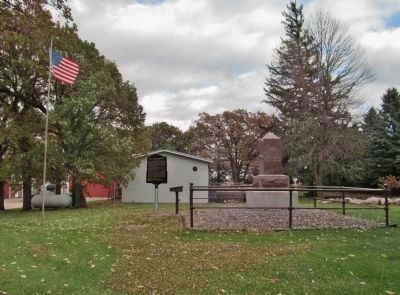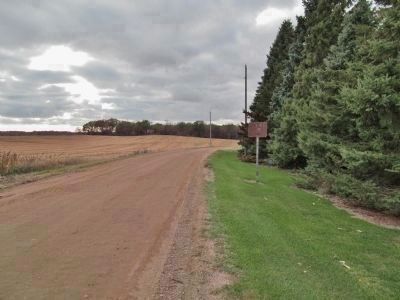Near Grove City in Meeker County, Minnesota — The American Midwest (Upper Plains)
The Acton Incident
On August 17, 1862, four young Dakota hunters, returning to their hungry families from an unsuccessful hunt, argued about stealing food from white settlers. Sungigidan, Kaomdeiyeyedan, Nagiwicakte, and Pazoiyopa dared each other this: who among them was brave enough to shoot the settlers? The youth spoke with Robinson Jones, Acton’s postmaster and storekeeper, at his farm. They followed him to this location, about a quarter mile from the home of Howard Baker. Here they shot and killed Baker, Viranus Webster and Robinson Jones and his wife. After they left, passing Jones’s home, they killed his daughter, Clara D. Wilson.
The Indians then fled 40 miles south to Rice Creek Village. After several council meetings, the Dakota who wanted to go to war with the United States convinced Taoyateduta (Little Crow) to lead them into battle. Thus began the U.S.–Dakota War of 1862, the bloodiest chapter in Minnesota history.
Although the war was ignited by the actions of a small band of teenage hunters, its causes were far deeper. By 1862, European Americans were pouring onto the ancestral lands of the Dakota. White leaders, determined to seize millions of acres of rich farmland, forced the Dakota onto reservations. The Dakota were expected to assimilate: to farm rather than hunt, to speak English, to cut their hair and wear unfamiliar clothing. Missionaries sought to replace the Dakota belief system with Christianity. The payments promised in the 1851 and 1858 treaties were illegally taken by traders or were late in delivery. Families were torn between the past and a foreign, uncertain future. To some, war seemed the only option.
The U.S.–Dakota War of 1862 launched 30 years of war between the United States and American Indians on the Northern Plains.
Clean Water, Land & Legacy Amendment
Minnesota Historical Society
Erected 2012 by the Minnesota Historical Society.
Topics and series. This historical marker is listed in these topic lists: Settlements & Settlers • Wars, US Indian. In addition, it is included in the Minnesota Historical Society series list. A significant historical year for this entry is 1862.
Location. 45° 6.366′ N, 94° 42.067′ W. Marker is near Grove City, Minnesota, in Meeker County. Marker is on 248th Street, 0.2 miles west of Minnesota Highway 4, on the right when traveling west. Marker is at a private residence. Touch for map. Marker is at or near this postal address: 53322 248th Street, Grove City MN 56243, United States of America. Touch for directions.
Other nearby markers. At least 8 other markers are within 7 miles of this marker, measured as the crow flies. Acton State Monument (here, next to this marker); Arndahl Lutheran Church (approx. 1.8 miles away); Battle of Acton (approx. 2˝ miles away); Andreas Olson (approx. 3.3 miles away); Backlund / Lorentson Monument (approx. 4.1 miles away); Ness Lutheran Church (approx. 4.8 miles away); Ness Cemetery State Monument (approx. 4.8 miles away); Wheeler Lake Camp (approx. 6˝ miles away). Touch for a list and map of all markers in Grove City.
More about this marker. A previous historical marker with outdated language was replaced with this marker in 2012. The content of this sign was reviewed by a Minnesota Historical Society historical marker committee, as well as by Dakota consultants and the Minnesota Historical Society Indian Advisory Committee. Funding for the marker provided from the Clean Water, Land and Legacy Amendment through the vote of Minnesotans on November 4, 2008. A visitor registration book is in the podium next to the marker.
Also see . . .
1. Dakota War of 1862. Wikipedia entry. "There has never been an official report on the number of settlers killed, although in Abraham Lincoln's second annual
address, he noted that not less than 800 men, women, and children had died." (Submitted on November 22, 2013.)
2. The U.S. - Dakota War of 1862. Minnesota Historical Society. (Submitted on November 22, 2013.)
Credits. This page was last revised on April 5, 2024. It was originally submitted on November 22, 2013, by Keith L of Wisconsin Rapids, Wisconsin. This page has been viewed 1,403 times since then and 156 times this year. Photos: 1, 2, 3, 4, 5. submitted on November 22, 2013, by Keith L of Wisconsin Rapids, Wisconsin.
